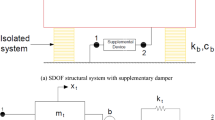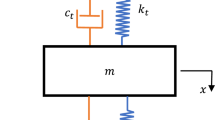Abstract
Studies on vibration control of stay cables in cable-stayed bridges have been keenly interested by researchers and engineers in designing new bridges and assessing in-service bridges. Mitigation of undesired cable vibration can be achieved by attaching a damping device. A Viscous Mass Damper (VMD) is composed by the arrangement a rotational Viscous Damper (VD) and an inertial mass element in parallel, which has been used to control seismic in many buildings in Japan; however, it has not been studied to apply in field of cable vibration control. This paper proposes the application of VMD to robustness in suppressing cable vibration. Oscillation parameters of the cable-VMD system are investigated in detail using an analytical formulation of the complex eigenvalue problem and compared with Viscous Damper (VD). Asymptotic formulas to calculate the complex eigenvalue solutions and the damping ratios of the cable with VMD installed in the proximity of the cable end are proposed, discussed and compared with the exact solutions. Further, the influence of elastic support on the VMD effectiveness of a cable-VMD system is analyzed and examined. Lastly, a case study is provided to justify the proposed methodology. The results of this study show that VMD can improve the cable damping ratio more efficiently than VD where the maximum damping ratio of VMD is larger than that of VD, and the increased damping ratio is higher when the relative modes are higher. The paper also provides necessary insights into the dynamics of the cable-VMD system and a useful tool for selecting optimal parameters of VMD for stay cables.
Similar content being viewed by others
References
Caracoglia, L. and Jones, N. P. (2007). “Damping of taut-cable systems: Two dampers on a single stay.” Journal of Engineering Mechanics, Vol. 133, No. 10, pp. 1050–1060, DOI: 10.1061/(ASCE)0733-9399 (2007)133:10(1050).
Carne, T. G. (1981). Guy cable design and damping for vertical axis wind turbine, SAND80-2669, Sandia National Laboratories, Albuquerque, New Mexico, USA.
Chen, L., Sun, L., and Nagarajaiah, S. (2015). “Cable with discrete negative stiffness device and viscous damper: Passive realization and general characteristics.” Smart Structures and Systems, Vol. 15, No. 3, pp. 627–643, DOI: 10.12989/sss.2015.15.3.627.
Cheng, S. H., Darivandi, N., and Ghrib, F. (2010). “The design of an optimal viscous damper for a bridge stay cable using energy-based approach.” Journal of Sound and Vibration, Vol. 329, No. 22, pp. 4689–4704, DOI: 10.1016/j.jsv.2010.05.027.
Cu, V. H. and Han, B. (2015). “A stay cable with viscous damper and tuned mass damper.” Australian Journal of Structural Engineering, Vol. 16, No. 4, pp. 316–323, DOI: 10.1080/13287982.2015.1092693.
Cu, V. H., Han, B., and Nguyen, T. N. (2015). “Optimal parameters of viscous damper for hanged cables in arch bridges.” KSCE Journal of Civil Engineering, Vol. 20, No. 2, pp. 847–854, DOI: 10.1007/s12205-015-0771-8.
Freyssinet (2005). BaiChay Bridge in Vietnam: Internal dampers - Efficiency estimation & Stay vibration analysis.Vietnam.
Fujino, Y. and Hoang, N. (2008). “Design formulas for damping of a stay cable with a damper.” Journal of Structural Engineering, Vol. 134, No. 2, pp. 269–278, DOI: 10.1061/(ASCE)0733-9445(2008) 134:2(269).
Fujino, Y., Kimura, K., and Tanaka, H. (2012). “Cable Vibrations and Control Methods.” In Wind Resistant Design of Bridges in Japan, pp. 197–229. Springer Japan.
Hikami, Y. and Shiraishi, N. (1988). “Rain-wind induced vibrations of cables stayed bridges.” Journal of Wind Engineering and Industrial Aerodynamics, Vol. 29, Nos. 1-3, pp. 409–418, DOI: 10.1016/0167-6105(88)90179-1.
Hoang, N. and Fujino, Y. (2007). “Analytical study on bending effects in a stay cable with a damper.” Journal of Enginnering Mechanics, Vol. 113, No. 11, pp. 1241–1246, DOI: 10.1061/(ASCE)0733-9399(2007)133:11(1241).
Hoang, N. and Fujino, Y. (2008). “Combined damping effect of two dampers on a stay cable.” Journal of Bridge Engineering, Vol. 13, No. 3, pp. 299–303, DOI: 10.1061/(ASCE)1084-0702(2008)13: 3(299).
Huang, Z. and Jones, N. P. (2011). “Damping of taut-cable systems: Effects of linear elastic spring support.” Journal of Engineering Mechanics, Vol. 137, No. 7, pp. 512–518, DOI: 10.1061/(ASCE)EM.1943-7889.0000252.
Ikago, K., Saito, K., and Inoue, N. (2012). “Seismic control of singledegree-of-freedom structure using tuned viscous mass damper.” Earthquake Engineering & Structural Dynamics, Vol. 41, No. 3, pp. 453–474, DOI: 10.1002/eqe.1138.
Irwin, P. A. (1997). Wind vibrations of cables on cable-stayed bridges. In: Building to Last (pp. 383–387). ASCE.
Kovacs, I. (1982). “Zur Frage der Seilschwingungen und der Seildämpfun.” Bautechnik, Vol. 59, No. 10, pp. 325–332 (in German).
Krenk, S. (2000). “Vibrations of a taut cable with an external damper.” Journal of Applied Mechanics, Vol. 67, No. 4, pp. 772–776, DOI: 10.1115/1.1322037.
Krenk, S. and Høgsberg, J. R. (2005). “Damping of cables by a transverse force.” Journal of Engineering Mechanics, Vol. 131, No. 4, pp. 340–348, DOI: 10.1061/(ASCE)0733-9399(2005)131:4(340).
Kumarasena, S., Jones, N. P., Irwin, P., and Taylor, P. (2007). Windinduced vibration of stay cables. Federal Highway Administration, Publication No. FHWA-RD-05-083.
Lazar, I. F., Neild, S. A., and Wagg, D. J. (2015). Performance analysis of cables with attached tuned-inerter-dampers. Dynamics of Civil Structures, Vol. 2, pp. 433–441, DOI: 10.1007/978-3-319-15248-6_44. Springer International Publishing.
Lazar, I. F., Neild, S. A., and Wagg, D. J. (2016). “Vibration suppression of cables using tuned inerter dampers.” Engineering Structures, Vol. 122, pp. 62–71, DOI: 10.1016/j.engstruct.2016.04.017.
Main, J. A. and Jones, N. P. (2002). “Free vibrations of taut cable with attached damper. I: Linear viscous damper.” Journal of Engineering Mechanics, Vol. 128, No. 10, pp. 1062–1071, DOI: 10.1061/(ASCE)0733-9399(2002)128:10(1062).
Matsumoto, M., Saitoh, T., Kitazawa, M., Shirato, H., and Nishizakiet, T. (1995). Response characteristics of rain-wind induced vibration of stay-cables of cable-stayed bridges. Journal of Wind Engineering and Industrial Aerodynamics, Vol. 57, No. 2-3, pp. 323–333, DOI: 10.1016/0167-6105(95)00010-O.
Matsumoto, M., Shirashi, N., and Shirato, H. (1992). Rain-wind induced vibration of cables of cable-stayed bridges. Journal of Wind Engineering and Industrial Aerodynamics, Vol. 43, No. 1-3, pp. 2011–2022, DOI: doi:10.1016/0167-6105(92)90628-N.
Pacheco, B., Fujino, Y., and Sulekh, A. (1993). “Estimation curve for modal damping in stay cables with viscous damper.” Journal of Structural Engineering, Vol. 119, No. 6, pp. 1961–1979, DOI: 10.1061/(ASCE)0733-9445(1993)119:6(1961).
PTI Guide Specification (2007). Recommendations for stay cable design, testing and installation. Post-Tensioning Institute Committee on Cable-Stayed Bridges (Fifth Edition).
Saito, K., Sugimura, Y., Nakaminami, S., Kida, H., and Inoue, N. (2008). “Vibration Tests of 1-story Response Control System Using Inertial Mass and Optimized Soft Spring and Viscous Element.” In: Proceedings of the 14th World Conference on Earthquake Engineering. Beijing, China.
Saito, T., Matsumoto, M., and Kitazawa, M. (1994). Rain-wind excitation of cables on cable-stayed Higashi-Kobe Bridge and cable vibration control. In: Proceedings of the International Conference on Cable-Stayed and Suspension Bridges (AFPC), Vol. 2, pp. 507–514. Deauville, France.
Sugimura, Y., Goto, W., Tanizawa, H., Saito, K., and Nimomiya, T. (2012). “Response control effect of steel building structure using tuned viscous mass damper.” In: 15th world conference on earthquake engineering. Lisbon, Portugal.
Sun, L. and Chen, L. (2014). “Free vibrations of a taut cable with a general viscoelastic damper modeled by fractional derivatives.” Journal of Sound and Vibration, Vol. 335, pp. 19–33, DOI: 10.1016/j.jsv.2014.09.016.
Tabatabai, H. and Mehrabi, A. (2000). “Design of mechanical viscous dampers for stay cables.” Journal of Bridge Engineering, Vol. 5, No. 2, pp. 114–123, DOI: 10.1061/(ASCE)1084-0702(2000)5:2(114).
Wang, X. Y., Ni, Y. Q., Ko, J. M., and Chen, Z. Q. (2005). “Optimal design of viscous dampers for multi-mode vibration control of bridge cables.” Engineering Structures, Vol. 27, No. 5, pp. 792–800, DOI: 10.1016/j.engstruct.2004.12.013.
Weber, F., Feltrin, G., Maslanka, M., Fobo, W., and Distl, H. (2009). “Design of viscous dampers targeting multiple cable modes.” Engineering Structures, Vol. 31, No. 11, pp. 2797–2800, DOI: 10.1016/j.engstruct.2009.06.020.
Wenzel, H. and Tanaka, H. (2006). Samco Monitoring glossary. Vienna Consulting Engineers Holding GmbH, Vienna, Austria.
Xu, Y.-L. (2013). Wind effects on cable-supported bridges. John Wiley & Sons.
Zhou, H., Sun, L., and Xing, F. (2014a). “Damping of full-scale stay cable with viscous damper: Experiment and analysis.” Advances in Structural Engineering, Vol. 17, No. 2, pp. 265–274, DOI: 10.1260/1369-4332.17.2.265.
Zhou, H., Sun, L., and Xing, F. (2014b). “Free vibration of taut cable with a damper and a spring.” Structural Control and Health Monitoring, Vol. 21, No. 6, pp. 996–1014, DOI: 10.1002/stc.1628.
Author information
Authors and Affiliations
Corresponding author
Rights and permissions
About this article
Cite this article
Cu, V.H., Han, B., Pham, D.H. et al. Free Vibration and Damping of a Taut Cable with an Attached Viscous Mass Damper. KSCE J Civ Eng 22, 1792–1802 (2018). https://doi.org/10.1007/s12205-017-1167-8
Received:
Accepted:
Published:
Issue Date:
DOI: https://doi.org/10.1007/s12205-017-1167-8




